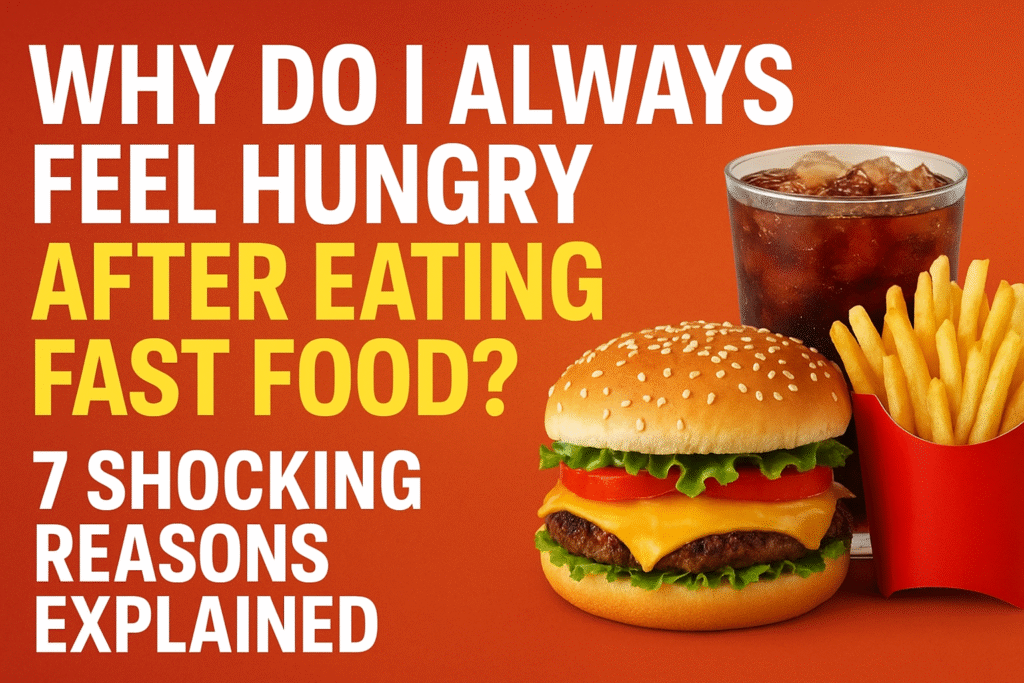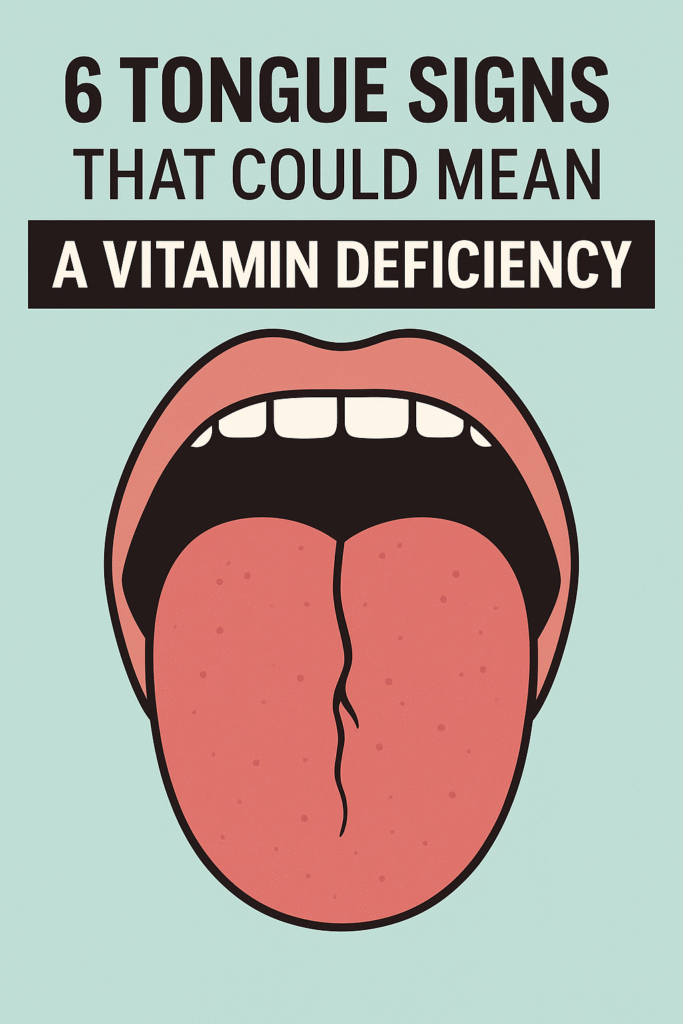
⚠️ Affiliate Disclaimer: This post may contain affiliate links, which means I may earn a small commission — at no extra cost to you — if you make a purchase through one of these links. I only recommend products or services I genuinely trust and believe can provide value. Thank you for supporting My Medical Muse!
Why Do I Always Feel Hungry After Eating Fast Food? 7 Shocking Reasons Explained
Why Do I Always Feel Hungry After Eating Fast Food?
Fast food is everywhere, quick, cheap, convenient, and undeniably tasty, but have you ever noticed that no matter how much you eat a burger, fries, and soda, you often find yourself feeling hungry again just an hour or two later?
This isn’t just your imagination. There are biological, psychological, and nutritional reasons why fast food leaves you craving more. In this article, we’ll break down the science behind it and share strategies to stay satisfied for longer, even if you enjoy fast food now and then.
The Fast Food Paradox
Fast food meals can easily add up to 800-1500 calories in one sitting, sometimes more than half of your daily needs. Yet, people often report feeling hungry shortly after eating. This is known as the fast food paradox, high in calories, but low in lasting satiety.
The reason is simple, calories don’t always equal fullness. Your body doesn’t just care about how many calories you eat, it also cares about where those calories come from. A meal rich in vegetables, lean protein, fiber, and healthy fats will trigger your body’s satiety hormones, slowing digestion and keeping you satisfied for hours.
Fast food, on the other hand, is typically built around refined carbs, processed fats, and minimal fiber. That means:
- Your stomach empties faster.
- Blood sugar rises and crashes quickly.
- Hunger signals return sooner.
It’s the difference between eating 600 calories of grilled chicken, brown rice, and veggies versus 600 calories of fries and nuggets. One will fuel you for the long haul, while the other barely gets you through the next hour.
How Fast Food Affects Your Hunger Hormones
Your appetite isn’t just about willpower, it’s regulated by a delicate balance of hormones that tell you when to eat and when to stop. The two key players are:
- Ghrelin: Often called the “hunger hormone.” It spikes before meals, signaling your body to eat, and should drop once you’re satisfied.
- Leptin: Known as the “satiety hormone.” It tells your brain that you’ve had enough and should stop eating.
Here’s where fast food throws things off:
- Refined carbs and sugar temporarily lower ghrelin (so you feel satisfied), but because they digest quickly, ghrelin rebounds fast, making you hungry again soon after.
- High-fat, high-sugar meals may dull leptin sensitivity over time. That means even when you’ve eaten enough calories, your brain doesn’t clearly get the message that you’re full.
The result? A cycle that looks like this:
Eat – Crave – Eat again
Even if you’ve already had more than enough calories, your body feels like it hasn’t gotten what it needs. This explains why you can polish off a full meal deal, only to find yourself reaching for snacks a short while later.
Blood Sugar Spikes and Crashes
Most fast food is made with refined carbohydrates, think white bread buns, fries, pizza crust, nuggets breading, and sweetened sauces. Unlike complex carbs from whole grains or vegetables, refined carbs are stripped of fiber and nutrients, which means they digest extremely quickly.
Here’s what happens inside your body:
- Quick Breakdown into Glucose
Once eaten, refined carbs convert rapidly into glucose (sugar) in your bloodstream. - Blood Sugar Spike
This sudden flood of glucose gives you a temporary energy boost and a short-lived sense of satisfaction. - Insulin Surge
Your pancreas releases insulin, a hormone that helps shuttle glucose into your cells. - The Crash
Because the rise was so sharp, insulin often overshoots, causing your blood sugar to drop below normal levels. - Hunger Rebound
Within an hour or two, you may feel tired, irritable, and hungry again, even though you consumed a hefty meal.
This rollercoaster effect is one of the biggest reasons why fast food doesn’t “stick.” Unlike a balanced meal that digests steadily, fast food sends your energy and appetite on a wild ride, leaving you constantly chasing the next bite.
4. Lack of Fiber and Protein
If you want to feel satisfied after a meal, two nutrients matter most: fiber and protein.
- Fiber acts like a slow-release mechanism for food. It bulks up your meal, delays stomach emptying, and stabilizes blood sugar. You find it in whole grains, beans, vegetables, and fruits.
- Protein signals satiety hormones such as peptide YY and GLP-1, while also preserving lean muscle mass. Foods like eggs, lean meats, fish, and legumes are protein powerhouses.
Unfortunately, most fast food meals fall short on both:
- They are low in fiber because they lack vegetables, beans, or whole grains.
- They provide moderate but low-quality protein, often coming from fried, processed, or heavily seasoned meats.
Without fiber and strong protein signals, your stomach empties quickly, and your hunger hormones rebound faster than they would with a balanced meal. This explains why that cheeseburger and fries don’t keep you satisfied nearly as long as a home cooked meal with grilled chicken, quinoa, and vegetables.
The “Bliss Point”: Salt, Fat, and Sugar
Fast food isn’t an accident, it’s engineered. Food scientists design meals to hit what’s called the “bliss point”: the ideal balance of salt, fat, and sugar that maximizes taste and triggers pleasure in the brain.
This formula does two things simultaneously:
- Makes food irresistible: You crave another bite, even when your stomach feels full.
- Blunts satiety signals: Your body doesn’t clearly send the “I’m done” message because the pleasure from flavor overpowers the natural stop cues.
That’s why you might breeze through an entire large fries or finish a milkshake even when you weren’t particularly hungry. The bliss point creates a subtle override between your taste buds and your satiety hormones, keeping your brain interested long after your body has had enough.
In contrast, a balanced home-cooked meal often triggers satiety midway through, you naturally slow down or stop eating, with fast food, that internal brake doesn’t kick in as strongly.
Fast Food and Dopamine (Your Brain’s Reward System)
Fast food isn’t just filling your stomach, it’s hacking your brain. These meals light up the dopamine pathways, the same reward circuits activated by drugs, gambling, and other addictive behaviors.
Here’s what happens:
- Immediate Dopamine Rush: When you bite into salty fries or sip a sweet milkshake, your brain releases dopamine, the feel-good neurotransmitter.
- Temporary High: You feel pleasure, comfort, and even relief from stress.
- Tolerance Builds: Over time, your brain adapts, releasing less dopamine in response to the same food. That means you need more fast food to achieve the same rewarding feeling.
This reward-loop disconnects your body’s needs from your brain’s cravings. Even if your stomach is physically full, your brain may push you toward another burger, another fry, or another late-night drive-thru run.
That’s why fast food cravings can feel so powerful, sometimes even stronger than actual hunger.
The Role of Liquid Calories
When most people think of fast food, they picture burgers and fries but the drinks are just as important in shaping hunger. Sodas, milkshakes, and sweet teas are staples of fast food meals, and while they may taste refreshing, they come with a hidden problem, liquid calories don’t register in the body the same way solid food does. Why?
- Liquids pass quickly through your digestive system, leaving your stomach emptier sooner.
- They don’t activate chewing or the same satiety hormones, so your brain doesn’t recognize them as filling.
- A single large soda can pack 200-400 calories, essentially the same as an extra burger, but without the lasting satisfaction.
That means you’re often eating a full meal plus drinking another one, without feeling like you’ve eaten more. Worse, the sugar in these drinks spikes your blood sugar and sets you up for another crash soon after.
This is why one of the simplest ways to reduce post-fast-food hunger is to swap soda or milkshakes for water or unsweetened iced tea. You’ll cut hundreds of empty calories and allow your stomach to focus on digesting real food.
Portion Size vs. Nutrient Density
Fast food restaurants are known for super-sized portions. A large fries or a giant combo meal feels filling in the moment, but fullness doesn’t last long because the food is low in nutrient density.
Here’s the distinction:
- Portion size: The total calories in a meal.
- Nutrient density: The amount of vitamins, minerals, fiber, and quality protein in those calories.
Your body isn’t just counting calories, it’s also scanning for nutrients. If you eat a calorie-heavy but nutrient-poor meal, your brain may continue to send out hunger signals as if to say:
“I got the energy, but not the nutrition I needed.”
This is why you can eat a burger, fries, and soda, feel stuffed for an hour, and then suddenly crave more food. It’s not about willpower, it’s your body still searching for missing nutrients like fiber, potassium, magnesium, or high-quality protein.
Contrast that with a nutrient-rich plate of salmon, brown rice, and vegetables. Even if the calorie count is lower, the nutrient balance keeps you satisfied for much longer.
Psychological Triggers and Habit Loops
Not all fast food hunger is physical. In fact, much of it comes from psychological conditioning. Fast food companies have spent decades perfecting the art of making you crave their products, even when your stomach isn’t asking for food.
Here are some of the biggest triggers:
- Advertising and Packaging: Bright colors, catchy jingles, and “limited-time deals” create a strong link between fast food and reward in your brain. Think about how a red-and-yellow logo can instantly make you think of fries.
- Stress Eating: High-fat, high-sugar foods are comfort foods. After a tough day, many people turn to fast food for emotional relief, mistaking stress cravings for hunger.
- Habit Loops: If you always grab fast food on your commute, your brain associates driving with eating, even if you’re not truly hungry. This conditioning makes cravings automatic.
Over time, these habit loops can blur the line between physical hunger and psychological desire. That’s why you might find yourself at the drive-thru “without thinking,” or ordering food after seeing an advert, even when you weren’t planning on eating.
Long-Term Effects of Frequent Fast Food on Appetite
An occasional fast food meal won’t ruin your hunger signals, but if it becomes a daily habit, the effects build up over time. Regular fast food consumption can:
- Reduce leptin sensitivity: making it harder for your brain to recognize when you’re full.
- Disrupt blood sugar stability: causing frequent cycles of hunger, fatigue, and energy crashes.
- Increase visceral fat (the fat around organs): which is linked to inflammation. Inflammation itself interferes with appetite-regulating hormones.
In other words, frequent fast food can actually rewire your hunger cues, making you crave more and feel less satisfied by normal foods. Over months and years, this cycle can make it much harder to distinguish between genuine hunger and food cravings created by habit and hormone disruption.
How to Stay Fuller After Eating Fast Food
Here’s the good news: you don’t have to give up fast food entirely. With a few smart strategies, you can enjoy it while minimizing the hunger rebound effect.
- Add Protein
Choose grilled chicken instead of fried, or add an egg or extra meat to your sandwich. Protein slows digestion and signals satiety hormones. - Add Fiber
Order a side salad, apple slices, or beans if available. Even a small serving of vegetables can make a difference in how long you stay full. - Skip the Soda
Replace sugary drinks with water, sparkling water, or unsweetened tea. This cuts hundreds of empty calories and avoids the sugar crash. - Balance Later Meals
If lunch was a burger and fries, make dinner rich in protein and fiber, like grilled fish with quinoa and vegetables. This helps balance your daily nutrition. - Eat Slowly
Fast food is often eaten quickly, but eating too fast prevents satiety hormones from catching up. Slow down, chew thoroughly, and give your body a chance to register fullness.
These small changes can dramatically improve how satisfied you feel after fast food, helping you avoid the constant hunger loop.
Healthier Fast Food Swaps
If fast food is a regular part of your routine, the good news is that you don’t have to overhaul your entire diet to feel better. Even small, mindful swaps can significantly reduce rebound hunger and improve satiety.
Here are some simple upgrades you can make:
- Burger Buns to Whole Grain or Lettuce Wrap
Whole grain buns contain more fiber, which slows digestion and keeps you fuller longer. If whole grain isn’t an option, many places now offer lettuce wraps for a lighter, low-carb choice. - Fries to Side Salad, Baked Potato, or Fruit Cup
Fries are calorie-dense but nutrient-poor. A side salad with light dressing or a baked potato offers fiber and nutrients. Some chains even offer apple slices or fruit cups, which help balance sugar spikes. - Fried Chicken to Grilled Chicken
Grilled chicken is lower in fat, lighter on your stomach, and provides lean protein, helping you stay satisfied longer. - Sauces to Mustard, Salsa, or Light Dressings
Creamy mayo-based sauces and ranch dressings pack hidden calories and fats. Opting for mustard, salsa, or vinaigrette adds flavor without sabotaging your meal. - Supersized Portions to Regular Sizes
Larger portions don’t necessarily fill you up for longer, they just pack more calories. Stick to standard sizes and pair your meal with water to avoid overeating.
These swaps may seem small, but over time they add up, helping you feel more energized, more satisfied, and less likely to end up hungry an hour later.
Final Thoughts
So, why do you always feel hungry after eating fast food? It comes down to a combination of factors:
- It’s low in fiber and protein, so your stomach empties quickly.
- It spikes and crashes your blood sugar, leaving you craving more.
- It tricks your hunger hormones, disrupting the balance between ghrelin and leptin.
- It activates dopamine pathways, creating cravings that override fullness.
- It’s calorie-dense but nutrient-poor, meaning your body gets energy but not the nutrition it really needs.
Fast food fills your stomach, but it rarely satisfies your body’s deeper nutritional requirements. That’s why you find yourself reaching for another bite, another snack, or even another meal not long after.
The good news? You don’t have to give it up completely. By making mindful choices, adding protein, choosing fiber-rich sides, skipping sugary drinks, and practicing portion control, you can still enjoy fast food without being trapped in the hunger cycle.
Remember, satisfaction isn’t just about calories, it’s about nutrients. Feed your body what it truly needs, and you’ll find that even the occasional fast food indulgence doesn’t leave you hungry again an hour later.
👩⚕️ Need Personalized Health Advice?
Get expert guidance tailored to your unique health concerns through MuseCare Consult. Our licensed doctors are here to help you understand your symptoms, medications, and lab results—confidentially and affordably.
👉 Book a MuseCare Consult NowRelated Blog Post You Might Like:
- 7 Powerful Everyday Causes Why You Crave Ice or Crunchy Foods
- Insomnia After Quitting Coffee: 7 Proven Fixes for Better Sleep
- 7 Natural Ways to Beat Afternoon Energy Crashes Without Coffee
- Why Do I Get Dizzy and Nauseous in the Shower? 7 Powerful Causes & Fixes
- 7 Powerful Reasons Why Your Ears Ring Randomly for a Few Seconds
- Why Do I Keep Getting Canker Sores in My Mouth? 10 Powerful Fixes


